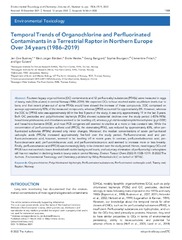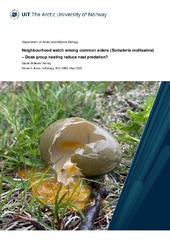Institutt for arktisk og marin biologi: Nye registreringer
Viser treff 621-640 av 2086
-
Temporal Trends of Organochlorine and Perfluorinated Contaminants in a Terrestrial Raptor in Northern Europe Over 34 years (1986–2019)
(Journal article; Tidsskriftartikkel; Peer reviewed, 2022-03-21)Fourteen legacy organochlorine (OC) contaminants and 12 perfluoroalkyl substances (PFASs) were measured in eggs of tawny owls (Strix alueco) in central Norway (1986–2019). We expected OCs to have reached stable equilibrium levels due to bans, and that recent phase-out of some PFASs would have slowed the increase of these compounds. ∑OC comprised on average approximately 92% of the measured compounds, ... -
Congruent responses to weather variability in high arctic herbivores
(Journal article; Tidsskriftartikkel; Peer reviewed, 2012-09-26)Assessing the role of weather in the dynamics of wildlife populations is a pressing task in the face of rapid environmental change. Rodents and ruminants are abundant herbivore species in most Arctic ecosystems, many of which are experiencing particularly rapid climate change. Their different life-history characteristics, with the exception of their trophic position, suggest that they should show ... -
Temporal correlations among demographic parameters are ubiquitous but highly variable across species
(Journal article; Tidsskriftartikkel; Peer reviewed, 2022-05-24)Temporal correlations among demographic parameters can strongly influence population dynamics. Our empirical knowledge, however, is very limited regarding the direction and the magnitude of these correlations and how they vary among demographic parameters and species’ life histories. Here, we use long-term demographic data from 15 bird and mammal species with contrasting pace of life to quantify ... -
Unexpected feeding behaviour inferred by DNA metabarcoding of Barents Sea skates
(Master thesis; Mastergradsoppgave, 2022-05-18)Feeding studies give an indication about the role and position of species within ecosystems and provide crucial knowledge for management. Traditional methods are based on morphological identification of prey. DNA metabarcoding is a promising tool that allow for identification of specific prey items, also when highly digested. A total of 63 stomachs from three skate species caught in the Barents Sea ... -
Neighbourhood watch among common eiders (Somateria mollissima) – Does group nesting reduce nest predation?
(Master thesis; Mastergradsoppgave, 2022-05-16)Colony nesting is thought to be an example of the selfish herd strategy, where aggregating behaviour may be an evolutionary adaptation to reduce the risk of predation. The common eider (Somateria mollissima) is a ground nesting sea bird susceptible to high nest predation rates through the nesting period. They often nest in groups, yet some also choose to nest solitarily. I examined whether group ... -
Phylogeny of Somniosus sleeper sharks: insights from newly sequenced mitochondrial genomes
(Master thesis; Mastergradsoppgave, 2022-05-16)Mitochondrial DNA (mtDNA) has been extensively used to explore phylogenetics since the its use became available. This science is considered useful in discerning relationships and evolutionary histories that are not possible with morphological studies alone. The sleeper sharks (genus: Somniosus) are a group of poorly understood, long-lived, iconic species whose taxonomic status within the genus have ... -
Can baleen whales be safely live-captured for studies of their physiology?
(Master thesis; Mastergradsoppgave, 2022-05-16)Studying baleen whales is challenging and complex, where observation of their habitat, sensory modalities, behavior and physiology, are infrequent and brief. The biochemical and biophysical contribution of mysticetes serve a vital role in maintaining a healthy marine ecosystem, but they are facing anthropogenic threats. Before giving any indications of how these threats affect the baleen whales, it ... -
Temporal trends in mercury concentrations in eggs of Tawny owl (Strix aluco) from Central Norway between 1986-2019: influence of dietary ecological parameters and climate variables
(Master thesis; Mastergradsoppgave, 2022-05-18)Mercury (Hg) is considered as a global threat which is emitted in the environment through natural sources or anthropogenic activities. Emissions of mercury decreased during the last decades because of the implementation of mitigation measures. However, with the ongoing climate change, ecosystems are directly (e.g., rising temperature) or indirectly impacted (i.e., altered ecosystem by e.g., invasive ... -
Circadian disruption by light and its effect on the immune function of the Atlantic salmon (Salmo salar)
(Master thesis; Mastergradsoppgave, 2022-05-16)The Atlantic salmon (Salmo salar) is an anadromous salmonid that begins its life cycle in freshwater streams then, develops, in a process known as smoltification, into a marine-adapted fish prior to its migration to the sea. Smoltification is a photoperiod regulated process which involves extensive change in the salmons’ physiology. In recent years smoltification procedures in aquaculture has been ... -
Environmental drivers of multi-species synchrony in seabird breeding success
(Master thesis; Mastergradsoppgave, 2022-05-16)Populations living close together in space are likely to experience more similar environmental fluctuations, and thus may display similar temporal changes in population parameters, in other words synchrony. Interspecific synchrony has implications for ecosystem stability, and highly synchronous populations and communities tend to have a higher risk of extinction. In this thesis, I used long-term ... -
Indirect food web interactions mediated by rodent cycles: Relative roles of lemmings and voles
(Journal article; Tidsskriftartikkel; Peer reviewed, 2013-12-23)Production cycles in birds are proposed as prime cases of indirect interactions in food webs. They are thought to be driven by predators switching from rodents to bird nests in the crash phase of rodent population cycles. Although rodent cycles are geographically widespread and found in different rodent taxa, bird production cycles appear to be most profound in the high Arctic where lemmings ... -
Towards a unifying pan-arctic perspective: A conceptual modelling toolkit
(Journal article; Tidsskriftartikkel; Peer reviewed, 2020-10-17)The Arctic Ocean is overwhelmingly forced by its lateral boundaries, and interacts with, the global system. For the development of nested conceptual models of the Arctic Ocean ecosystem we here choose the full pan-Arctic as our focal scale. Understanding the pan-Arctic scale, however, requires that we look at the underlying scales of its major components, by considering regionality, connectivity and ... -
Transcriptome analysis reveals a high aerobic capacity in the whale brain
(Journal article; Tidsskriftartikkel; Peer reviewed, 2019-10-30)The brain of diving mammals is repeatedly exposed to low oxygen conditions (hypoxia) that would have caused severe damage to most terrestrial mammals. Some whales may dive for > 2 h with their brain remaining active. Many of the physiological adaptations of whales to diving have been investigated, but little is known about the molecular mechanisms that enable their brain to survive sometimes ... -
Pelagic ecosystem dynamics between late autumn and the post spring bloom in a sub-Arctic fjord
(Journal article; Tidsskriftartikkel; Peer reviewed, 2022-05-13)Marine ecosystems, and particularly fjords, are experiencing an increasing level of human activity on a yearround basis, including the poorly studied winter period. To improve the knowledge base for environmentally sustainable management in all seasons, this study provides hydrographic and biological baseline data for the sub-Arctic fjord Kaldfjorden, Northern Norway (69.7 N, 18.7 E), between ... -
Thyroid hormone and seasonal rhythmicity
(Journal article; Tidsskriftartikkel; Peer reviewed, 2014-02-26)Living organisms show seasonality in a wide array of functions such as reproduction, fattening, hibernation, and migration. At temperate latitudes, changes in photoperiod maintain the alignment of annual rhythms with predictable changes in the environment.The appropriate physiological response to changing photoperiod in mammals requires retinal detection of light and pineal secretion of melatonin, ... -
Circuit-level analysis identifies target genes of sex steroids in ewe seasonal breeding
(Journal article; Tidsskriftartikkel; Peer reviewed, 2020-05-15)Thyroid hormone (TH) and estradiol (E2) direct seasonal switches in ovine reproductive physiology. In sheep, as in other mammals and birds, control of thyrotropin (TSH) production by the pars tuberalis (PT) links photoperiod responsiveness to seasonal breeding. PT-derived TSH governs opposite seasonal patterns of the TH deiodinases Dio2/Dio3 expression in tanycytes of the neighboring medio-basal ... -
Highly Productive Ice Algal Mats in Arctic Melt Ponds: Primary Production and Carbon Turnover
(Journal article; Tidsskriftartikkel; Peer reviewed, 2022-04-12)Arctic summer sea ice extent is decreasing and thinning, forming melt ponds that cover more than 50% of the sea ice area during the peak of the melting season. Despite of this, ice algal communities in melt ponds are understudied and so are their contribution to the Arctic Ocean primary production and carbon turnover. While melt ponds have been considered as low productive, recent studies suggest ... -
Fauna crime: elucidating the potential source and introduction history of European smelt (Osmerus eperlanus L.) into Lake Storsjøen, Norway
(Journal article; Tidsskriftartikkel; Peer reviewed, 2015-05-01)The ability to accurately determine the original source of invading species offers several powerful applications in invasive species ecology and management and may enable important information on the invading species in its native habitat. Lake Storsjøen in South-Central Norway was recently found to have been subjected to an illegal translocation of the European smelt (Osmerus eperlanus). The ... -
Round-trip migration and energy budget of a breeding female humpback whale in the Northeast Atlantic
(Journal article; Tidsskriftartikkel; Peer reviewed, 2022-05-27)In the northern hemisphere, humpback whales (<i>Megaptera novaeangliae</i>) typically migrate between summer/autumn feeding grounds at high latitudes, and specific winter/spring breeding grounds at low latitudes. Northeast Atlantic (NEA) humpback whales for instance forage in the Barents Sea and breed either in the West Indies, or the Cape Verde Islands, undertaking the longest recorded mammalian ... -
Oceanic drivers of juvenile sea turtle strandings in the UK.
(Journal article; Tidsskriftartikkel; Peer reviewed, 2022-05-05)Juvenile sea turtles can disperse thousands of kilometers from nesting beaches to oceanic development habitats, aided by ocean currents. In the North Atlantic, turtles dispersing from American beaches risk being advected out of warm nursery grounds in the North Atlantic Gyre into lethally cold northern European waters (e.g. around the UK). We used an ocean model simulation to compare simulated ...


 English
English norsk
norsk


















